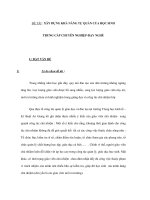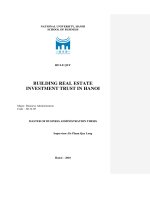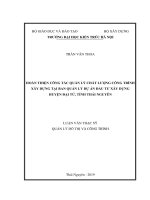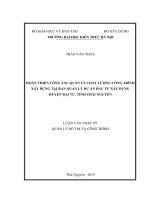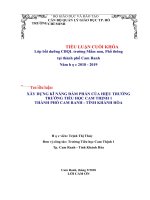Xây dựng kĩ năng tự tin
Bạn đang xem bản rút gọn của tài liệu. Xem và tải ngay bản đầy đủ của tài liệu tại đây (2.62 MB, 164 trang )
Copyright © 2018 by Althea Press, Emeryville, California
No part of this publication be reproduced, stored in a retrieval system, or transmitted in any form
or by any means, electronic, mechanical, photocopying, recording, scanning, or otherwise,
except as permitted under Sections 107 or 108 of the 1976 United States Copyright Act, without
the prior written permission of the Publisher. Requests to the Publisher for permission should be
addressed to the Permissions Department, Althea Press, 6005 Shellmound Street, Suite 175,
Emeryville, CA 94608.
Limit of Liability/Disclaimer of Warranty: The Publisher and the author make no representations
or warranties with respect to the accuracy or completeness of the contents of this work and
specifically disclaim all warranties, including without limitation warranties of fitness for a
particular purpose. No warranty may be created or extended by sales or promotional materials.
The advice and strategies contained herein may not be suitable for every situation. This work is
sold with the understanding that the Publisher is not engaged in rendering medical, legal, or other
professional advice or services. If professional assistance is required, the services of a competent
professional person should be sought. Neither the Publisher nor the author shall be liable for
damages arising herefrom. The fact that an individual, organization, or website is referred to in
this work as a citation and/or potential source of further information does not mean that the
author or the Publisher endorses the information the individual, organization, or website may
provide or recommendations they/it may make. Further, readers should be aware that websites
listed in this work may have changed or disappeared between when this work was written and
when it is read.
For general information on our other products and services or to obtain technical support, please
contact our Customer Care Department within the United States at (866) 744-2665, or outside the
United States at (510) 253-0500.
Althea Press publishes its books in a variety of electronic and print formats. Some content that
appears in print may not be available in electronic books, and vice versa.
TRADEMARKS: Althea Press and the Althea Press logo are trademarks or registered trademarks
of Callisto Media Inc. and/or its affiliates, in the United States and other countries, and may not
be used without written permission. All other trademarks are the property of their respective
owners. Althea Press is not associated with any product or vendor mentioned in this book.
Cover and Interior Designer: Merideth Harte
Editor: Susan Randol
Production Editor: Erum Khan
Illustrations: Merideth Harte
ISBN: Print 978-1-64152-148-2 | eBook 978-1-64152-149-9
QUICK START GUIDE
Is this book for you? Check the boxes that often describe you:
□
□
□
□
□
□
□
□
□
□
Do you keep your thoughts to yourself, assuming you don’t
have anything important to share?
If you’re not completely sure you can do something, do you
think, “Why bother trying?”
Do you avoid talking to people, worrying that you’ll have
nothing to say or come across as awkward?
Do you second-guess yourself frequently?
Do you apologize excessively, even when you haven’t done
anything wrong?
Do you hold yourself back from taking risks because you’re
afraid you’ll fail?
When you feel you didn’t perform well, do you spend lots of
time afterward ruminating on your mistakes?
Do you give up easily?
Does your inner voice tell you, “I’m not good enough; I can’t do
it”?
Do you avoid pursuing some of your goals and dreams because
of fear and self-doubt?
If you checked several of the boxes, read on to learn about proven
strategies to build your self-confidence.
To you, the reader:
May you have the confidence to show up, stand up, and speak up.
The world needs your gifts.
CONTENTS
Foreword
Introduction
PART 1: SETTING THE STAGE
Chapter 1:
Chapter 2:
Understanding Self-Confidence
Setting Goals and Getting Started
PART 2: THE STRATEGIES
Chapter 3:
Chapter 4:
Chapter 5:
Chapter 6:
Chapter 7:
Chapter 8:
Practice Acceptance
Calm Your Body
Work with Your Thoughts
Work with Your Beliefs
Face Your Fears
Moving Forward
Resources
References
Acknowledgments
About the Authors
HOW TO USE THIS WORKBOOK ON AN
EBOOK DEVICE
If you’re reading this workbook on a touch-screen device, you can add
notes and highlight text just like you would in a physical workbook.
Some sections will prompt you to write in answers or personal responses.
It’s easy—give it a try right here: ___________.
With your finger, tap and hold for a few moments on the line above.
Depending on the device you’re using, an icon such as a magnifying glass
will appear. Lift your finger and you’ll see an options menu. Select “Note”
(or “Notes”) to add and save your own text. When you’re done, an icon or
highlighted area will remain, which you can always return to and tap if
you want to reopen and read or edit your note.
The same tap-and-hold options menu offers “Highlight” or “Color,” which
you can select if you want to highlight a passage or “check” a box.
Experiment with it: By swiping your finger before releasing you can select
entire sentences or paragraphs. The options menu also offers “Bookmark”
for when you want quick access back to certain pages.
This method is the same on nearly all touch-screen ebook devices, but
some have slight variations. If you’d like more information specific to the
device you’re holding in your hands, a quick online search will yield best
results.
FOREWORD
RESEARCH HAS SHOWN that self-confidence is linked to
almost everything we want in life: success at work, secure relationships, a
positive sense of self, and happiness. But what is self-confidence? Why
does it appear to be so mysterious? Why does it seem like other people
have it and we don’t?
In my work as a psychologist, I often find low self-confidence is a
common denominator regardless of the problem people come in for. For
example, I worked with a young man who suffered from loneliness but
was afraid to ask anyone out on a date. He didn’t believe he was attractive
enough, or interesting enough, or fun enough. Another client I worked with
was a successful businesswoman who was experiencing severe burnout.
She took on too many projects, didn’t delegate well, and was prone to
perfectionism. Underneath it all, she felt like an impostor, and she
overworked herself to compensate. Both, at their core, lacked selfconfidence.
My clients typically say, “I don’t feel confident, so I couldn’t possibly
. . . [insert desired goal here].” Can you relate? Not many of us are taught
how confidence truly works. We get it backwards: We believe we have to
wait until we feel confident before we can act confidently. That is why I
am so excited you have this book in your hands. You are finally going to
learn the truth about confidence: what it is, where it comes from, and how
to master the rules of the confidence game. No matter your personality or
circumstances, this workbook will show you how to move from passivity
to actively pursuing your goals.
As a therapist, I’m also excited to have this book as a resource. I
frequently assign reading and outside activities to my clients, and The
Self-Confidence Workbook fills a much-needed gap. It’s grounded in the
latest advances in Cognitive Behavioral Therapy (CBT) and Acceptance
and Commitment Therapy (ACT), yet it’s reader-friendly, presenting the
skills you need in easy-to-digest nuggets. Each chapter contains valuable
exercises and includes highly practical action items. Although the book is
grounded in science, you won’t get bogged down in technical jargon or
long explanations of theory.
I first met Dr. Barbara Markway when we both worked at the Anxiety
Disorders Center at the St. Louis University School of Medicine over
twenty years ago. I was a psychologist and she was a postdoctoral fellow
completing advanced training in Cognitive Behavioral Therapy. A skilled
and caring therapist, she was also passionate about writing. She was adept
at taking scientific information and putting it in everyday language in
order to help people beyond her own office.
During her time at the Center for OCD and Anxiety-Related Disorders,
we co-authored, along with Dr. Alec Pollard and Dr. Cheryl Carmin, Dying
of Embarrassment: Help for Social Anxiety and Phobia . Dr. Markway
went on to write two other books for those suffering with shyness and
social anxiety, Painfully Shy and Nurturing the Shy Child . In addition to
her writing, she maintained a clinical practice in a number of settings,
from outpatient mental health clinics to private practice.
Dr. Markway has helped thousands of people build confidence and
accomplish things they never dreamed possible, and I can’t think of a
better guide for you in your own journey to self-confidence.
I wish you well on this journey.
Teresa Flynn, PhD
Psychologist and Author
Adjunct Professor of Psychology
Washington University, St. Louis, Missouri
INTRODUCTION
I HAVE A CONFESSION TO MAKE. If you asked me
to describe myself, I’d use words such as creative , kind , persistent , and
hardworking . But I don’t think self-confident would even make the top 10
list of adjectives. That’s because when I’ve historically thought of selfconfidence, I’ve pictured someone flashy and bold, and I’m definitely not
that. But what I’ve learned is that self-confidence doesn’t have to look
flashy. In fact, self-confidence has more to do with inner resolve than with
outward bravado.
I actually have a healthy degree of self-confidence now, but it wasn’t
always that way. I grew up a shy, anxious kid who rarely spoke to people
other than my close friends and family. Although bright, I never raised my
hand in class to answer a question. I was too afraid even to ask to go to the
bathroom. In high school, my math teacher announced to the whole class
that I was the quietest kid he had ever taught in his entire teaching career. I
was humiliated. Everyone turned around to look at me, and I could feel my
face turning hot and red. I went on to college and continued to do well in
school, but never dated or enjoyed much of a social life. I was always
interested in psychology, partly because I was trying to understand myself.
Why was I so shy and quiet? Why couldn’t I just break out of my shell?
Why couldn’t I just be myself? I ended up in graduate school studying
clinical psychology and earned my PhD.
Along the way, I went through a lot of psychotherapy that proved very
helpful. I learned to speak up. I learned my opinion mattered. I also
learned it was okay to be wrong. I even mustered up the courage to ask my
now-husband of nearly 30 years out on a date. Somewhere along the way, I
became self-confident—I just didn’t label it as such.
I became a psychotherapist and was naturally drawn to helping people
with anxiety. There is nothing more satisfying than helping people learn to
believe in themselves and master something that once terrified them. I
also went on to write three books on overcoming social anxiety and
shyness.
Over my nearly 30-year career, whether it’s been through face-to-face
therapy sessions or through my writing, I have helped thousands of people
learn to be more self-confident. They’ve all had something they wanted to
do—something important, something they valued—but they were letting
fear, doubt, and lack of confidence stand in their way. I’m guessing that if
you’ve picked up this book, you may be in the same boat.
The good news is you’re completely normal. I know when you’re in
the middle of a self-confidence crisis, it can seem like you’re the only one
struggling and that everyone else has it all together. But you’re not alone,
and this book will help. I’m excited to share with you all I’ve learned
about building a meaningful, confident life.
I’ve enlisted the help of a friend and fellow writer, Celia Ampel. As a
shy person, she started reading my work while studying journalism at the
University of Missouri. As a reporter, she has also overcome many of the
fears that used to overwhelm her as a kid—she no longer has to write out a
script before making a phone call—and much of that progress is thanks to
the tools you’ll learn in this book. Although we’re creating this book as a
team, we know it can be confusing to switch back and forth between us,
alerting the reader to who is saying what. So this book is written in my
“voice.”
While I hope this book will be helpful, I’m not suggesting that after
reading it you will never doubt yourself again. It’s not realistic to expect
yourself to have unshakable self-confidence. Everyone struggles with selfdoubt and lack of confidence from time to time. It’s part of being human.
What this book will do is teach you tools, grounded in science, to help
keep your self-critic from jerking you around. You’ll learn to set
meaningful goals, deal with your inner doubts, and not second-guess
yourself all the time. You’ll be able to walk out on that stage, ask for a
raise, write that blog post, or ask someone out on a date. I’m not saying it
will always be easy, but it will be possible. And you won’t be on the
journey alone. I’ll be guiding you all the way.
PART 1
SETTING THE STAGE
ackling the demons of self-doubt is a brave and worthy pursuit. At
times, you’re going to feel discouraged or scared, but that just means
you’re really trying, which is infinitely better than allowing low selfconfidence to keep you on the sidelines of life. The first two chapters of
this book will lay the foundation for the work you’ll do to bolster your
self-confidence in later sections.
In chapter 1 , we’ll dismantle common misconceptions about selfconfidence and learn what it really is, where it comes from, and most
importantly, that you are totally capable of attaining it. You’ll get a sense
of how confident you are right now, setting a baseline from which to
measure your growth. You’ll see how different life can be when you have
the gusto to go for your goals.
In chapter 2 , you’ll examine what’s really important to you,
identifying the values closest to your heart so that you can make an action
plan that aligns with who you want to be. Then you’ll set goals,
envisioning a life where self-doubt doesn’t hold you back from advancing
in your career, setting a good example for your kids, facing conflict,
building strong relationships, or making a difference in your community.
You’ll learn about the science behind the tried-and-true methods this book
is based on, all of which will help you get out of your own way and be the
best version of yourself. So give yourself a pat on the back for getting
started, and let’s go!
T
CHAPTER 1
UNDERSTANDING SELFCONFIDENCE
“IF YOU HEAR A VOICE WITHIN YOU SAYING,
‘YOU CANNOT PAINT,’ THEN BY ALL MEANS
PAINT AND THAT VOICE WILL BE SILENCED.”
—VINCENT VAN GOGH
If you had all the confidence in the world, what would you do?
Larry would start that novel he’s been wanting to write.
Rita would talk to her boss about the promotion she was promised six
months ago.
LaShonda would talk to her partner about how she’s been feeling
disconnected in the relationship.
What about you?
What would you do if you had all the confidence in the world? Take a
minute and jot down the first thing that comes to mind.
------------------------------------------------------------------------------------------------------------------------------------------------------------------------------------------------------------------------------------------------------
Larry, Rita, and LaShonda don’t want confidence simply for the sake of
confidence.
Larry wants to express his creativity.
Rita wants to stick up for herself.
LaShonda wants to improve her relationship.
My guess is there’s something you want, but self-doubt and insecurity
are holding you back. That’s why I wrote this workbook: to help you take
steps toward being your best self.
In this chapter, I will define self-confidence and what it can do for you.
Together, we’ll explore some myths about what confidence looks like and
explain its true origins. Then we’ll examine where low self-confidence
comes from: Which life experiences might have shaped your beliefs about
yourself? At the end of the chapter, you’ll take a self-assessment to
determine your current level of confidence.
Start at the Source
Confidence is a mysterious quality. It’s one of those things we’d all like to
have, but what does it really mean to be confident?
Most of the time, it’s defined as a feeling: “I feel confident I can run the
5K in 28 minutes.” We typically associate this type of confidence with
calm, ease, and assurance. When we feel confident, we anticipate being
successful.
The problem with defining confidence as a feeling is that in practice it
becomes a catch-22: If you don’t feel confident, you’re not likely to try.
There’s another definition of confidence, although it’s not as common.
The Latin roots of confidence mean “with trust.” Acting with trust usually
means you’re not completely certain of what you’re doing—you’re taking a
leap of faith. In other words, it’s what we do that matters, not so much how
we feel when we’re doing it.
We can see this principle in action by considering the example of
Darnell, a man who ordinarily kept to himself. Darnell was passionate about
a zoning issue affecting his neighborhood, but he didn’t like attention and
feared standing up in front of the city council to speak his mind.
However, after reminding himself of how important the issue was to
him and his neighbors, Darnell showed up to the meeting and said his piece,
even as his hands shook. He didn’t wait for his nervousness to subside
entirely—then he might never have been able to speak. Instead, he gathered
courage by rooting himself in his beliefs and then taking action.
In this book, I’ll use the following definition of self-confidence: the
willingness to take steps toward valued goals, even if you’re anxious and
the outcome is unknown. True self-confidence is part courage, part
competence, with a healthy dose of self-compassion mixed in. I’ll break
this definition into bite-size chunks as we move through the workbook. For
now, the key points to remember are:
Actions come before feelings.
Actions are guided by values—the things you care about.
Process is more important than outcome.
WHERE CONFIDENCE COMES FROM
Our beliefs about ourselves are often shaped by those around us, including
family, friends, and media messages, sociologists have found. But that
doesn’t mean your level of confidence is out of your control—in fact, it’s
quite the contrary.
Confidence comes from being grounded in your sense of self:
remembering who you are, what you value, and the hard work you’ve put in.
Studies show that a simple thought exercise can help people decrease
their anxiety ahead of having to perform a task in a high-stakes situation. In
research led by psychologists David Creswell and David Sherman,
participants were asked to take a moment to reflect on a core value—say,
being a good friend or respecting the environment. Then, each person wrote
about a memory of a time they embodied that value.
Those who did the exercise had far lower adrenaline levels heading into
stressful situations, such as exams or public speeches, than those who didn’t
—even if the core values weren’t at all relevant to the task at hand. What
mattered was that the participants were contemplating a deep truth about
themselves, rather than a hollow slogan, such as “I’m the best.” I’ll walk
you through some similar exercises in chapter 2 .
A connection to our authentic selves can also help us take some of the
pressure off ourselves going into scary situations. When Tanya was set to
give a toast at her sister’s wedding, she was extraordinarily anxious about
having all eyes on her. She worried about her hands shaking and her voice
quavering. But when she thought about it, impressing all 200 guests with a
perfectly delivered speech didn’t truly matter to her. What was really
important to Tanya was showing her sister and new brother-in-law how
much she loved them and hoped for their happiness. With that principle in
mind, she stood up at the ceremony with mostly calm nerves and gave a
heartfelt toast that strengthened the bonds she valued the most.
Of course, not all self-doubt is a bad thing! Sometimes fear is a signal
that we haven’t prepared enough for the big presentation, the recital, or the
interview. Practicing what you plan to say and do will give your mind
something to fall back on when the pressure is high. The voice of self-doubt
may also be saying we need to get more information, move in a different
direction, or take a break.
But we often err on the side of hesitating too much. Once you’ve put in
the hours of practice, you should be able to take action without obsessing
over what might go wrong. In this book, we will provide you with the tools
to adjust your mind-set to a place of confidence.
QUIET CONFIDENCE
“There’s zero correlation between being the best
talker and having the best ideas.”
—SUSAN CAIN
Have you ever felt like you had a great idea, but you weren’t confident
enough to share it? Maybe you thought you weren’t outgoing enough,
assuming that only talkative people get noticed.
It’s true that society tends to place more value on extroversion.
That means if you’re an introvert, you may have struggled more with
self-confidence, feeling like you don’t fit in or are somehow defective.
Fortunately, thanks in part to Susan Cain’s best-selling book,
Quiet: The Power of Introverts in a World That Can’t Stop Talking,
introverts are coming into their own, and many of the myths about
introversion are being challenged.
So, if you’re a self-described introvert, don’t worry. You are not
going to have to change your personality to enjoy greater selfconfidence. As Mahatma Gandhi wisely said, “In a gentle way, you can
shake the world.”
WHAT IT MEANS TO BE CONFIDENT
When you envision a confident person, you might think of someone who
takes big, bold actions, like running for office or proposing marriage on the
jumbotron. But there can be a lot of boldness and bravery in small steps.
Confidence isn’t something you have to possess every moment of every
day. Nor should you expect to jump instantly into perfect self-assurance
tomorrow. Instead, confidence is a choice to take steps to act in line with
your values.
Those incremental changes build on themselves, both through our own
feelings of accomplishment and reinforcement from others. But in order to
set off that virtuous cycle, it’s important to practice self-compassion:
speaking to yourself with the kindness and patience you would show a loved
one or a child.
For example, when Sofia moved to a new city with her husband, she
knew she wanted to make more friends. She heard about a free poetry
workshop at a local café, and although she enjoyed writing, she was hesitant
to attend. What if she had to read her amateur poetry in front of everyone?
Sofia told herself it was okay just to go, even if she didn’t speak up as
much as other people. She introduced herself to a few others at the table and
participated in the writing prompts, but stayed silent when the instructor
asked for volunteers to read their poems. At the very end of the event, she
raised her hand once to thank the teacher for the workshop.
On the way home, Sofia had a choice. She could let her inner critic run
wild, saying, You’re such a weirdo . . . You sat there silently the whole night
. . . People probably wondered why you were even there, and they found you
unfriendly, too! Those thoughts would probably convince her the night had
been a failure and that she should never go back to the monthly meetings.
Or, instead, Sofia could congratulate herself. She could see attending
the workshop as a big, bold step—hey, by thanking the instructor, she even
spoke in front of the whole group! Next month, she can set a goal to go
back, have more conversations with the other participants, and maybe even
share her writing. Her self-compassion, a concept we’ll explore more later
in the book, will allow her confidence to grow.
As Sofia shows us, you don’t have to change your personality to be
confident. There is emotional complexity in confidence. You can be strong
and bold, but also honest, kind, and comfortable.
Think about a time you let your inner critic stop you from trying
something new. What could you say to yourself next time to be more selfcompassionate?
------------------------------------------------------------------------------------------------------------------------------------------------------------------------------------------------------------------------------------------------------------------------------------------------------------------------------------------------------------------------------------------------------------------------------
WHAT CONFIDENCE IS NOT
Some of us fear confidence because we don’t want to start stepping on other
people’s toes, taking up too much space, or just plain being a jerk. But
confidence isn’t the same as arrogance or narcissism. In fact, when we feel
confident in ourselves, we often become less self-absorbed. When we stop
worrying so much about how we’re coming across, we can pay more
attention to those around us.
Confidence is not about being the one who speaks the loudest or who
dominates every moment. It’s also not about having a fancy car or other
symbols of wealth or status. It’s about being rooted in who you really are,
freeing up your mind from obsessive worry and self-doubt.
Confidence is about being rooted in who you really are.
Staying grounded in a sense of self includes having a realistic view of
your strengths as well as your weaknesses. Confidence can be a helpful
buffer against internalizing unhelpful criticism that doesn’t have much to
do with what you really value—for instance, you can let your mother-inlaw’s comment about your hairstyle roll off your back. That doesn’t mean
you ignore all criticism because you believe you’re already perfect.
On the contrary, a confident person can accept helpful feedback and act
on it without getting defensive. When your sense of self-worth is no longer
on the table, you can handle criticism or even outright rejection without
allowing it to break you.
By the same token, confidence doesn’t mean you mow other people
down when a conflict arises. It’s possible to speak your mind with
conviction and still make room to listen to someone else’s point of view,
and even reach a compromise.
Lastly, confidence doesn’t mean you won’t fail. It doesn’t mean you’re
always smiling or that you never experience anxiety or self-doubt. Instead,
it means you know you can handle those feelings and push through them to
conquer the next challenge.
Who is someone you think embodies confidence and why?
-------------------------------------------------------------------------------------------------------------------------------------------------------------------------------------------------------------------------------------------------------
------------------------------------------------------------------------------------------------------------------------------------------------------------------------
THE CONFIDENCE CURVE
Did you ever think you could have too much self-confidence? Let’s
look at an example that shows how self-confidence is all about
balance. Too little confidence and you avoid trying new things, pass on
taking even small risks, and miss out on engaging in activities that
would make life more meaningful and enjoyable. Too much confidence
—confidence not grounded in reality—can get you into trouble.
Let’s look at this in action. Imagine you’re scheduled to give a
presentation. The chart below shows the difference between being
confident and overconfident.
Confident
Overconfident
I am well prepared. I know I can do this.
I know this material so well, I’m not
going to prepare.
I will do my best to connect with the audience.
The audience better love me.
I might not give a flawless presentation, but I’ll
learn from my mistakes.
I’m too perfect to make a mistake.
I’ll listen to the audience’s questions and then
thoughtfully respond.
I’ll just wing the Q and A part.
It’s OK if I don’t have all the answers.
I’m the expert. I know everything.
Although this example might seem extreme, it illustrates some
important points. First, confidence involves preparation. You have to
put in the needed work ahead of time. Second, confidence doesn’t
mean you won’t make mistakes; you will, but the mistakes won’t crush
you. You’ll take the feedback and learn from it. And finally, confidence
involves listening.
Reasons for Low Self-Confidence

